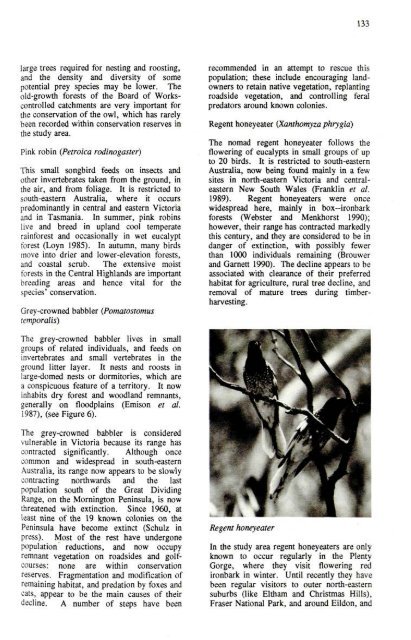Factors Affecting Flora Conservation - Victorian Environmental ...
Factors Affecting Flora Conservation - Victorian Environmental ...
Factors Affecting Flora Conservation - Victorian Environmental ...
You also want an ePaper? Increase the reach of your titles
YUMPU automatically turns print PDFs into web optimized ePapers that Google loves.
133<br />
large trees required for nesting and roosting,<br />
and the density and diversity of some<br />
potential prey species may be lower. The<br />
old-growth forests of the Board of Workscontrolled<br />
catchments are very important for<br />
die conservation ofthe owl, which has rarely<br />
been recorded within conservation reserves in<br />
the study area.<br />
Pink robin (Petroica radinogaster)<br />
This small songbird feeds on insects and<br />
other invertebrates taken from the ground, in<br />
die air, and from foliage. It is resfricted to<br />
south-eastern Australia, where it occurs<br />
predominanfly in central and eastern Victoria<br />
and in Tasmania. In summer, pink robins<br />
live and breed in upland cool temperate<br />
rainforest and occasionally in wet eucalypt<br />
forest (Loyn 1985). In autumn, many birds<br />
move into drier and lower-elevation forests,<br />
and coastal scmb. The extensive moist<br />
forests in the Central Highlands are important<br />
breeding areas and hence vital for the<br />
species' conservation.<br />
Grey-crowned babbler (Pomatostomus<br />
temporalis)<br />
recommended in an attempt to rescue this<br />
population; these include encouraging landowners<br />
to retain native vegetation, replanting<br />
roadside vegetation, and controlling feral<br />
predators around known colonies.<br />
Regent honeyeater (Xanthomyza phrygia)<br />
The nomad regent honeyeater follows the<br />
flowering of eucalypts in small groups of up<br />
to 20 birds. It is restricted to south-eastern<br />
Australia, now being found mainly in a few<br />
sites in north-eastern Victoria and centraleastern<br />
New South Wales (Franklin et al.<br />
1989). Regent honeyeaters were once<br />
widespread here, mainly in box-ironbark<br />
forests (Webster and Menkhorst 1990);<br />
however, their range has contracted markedly<br />
this century, and they are considered to be in<br />
danger of extinction, with possibly fewer<br />
than 1000 individuals remaining (Brouwer<br />
and Garnett 1990). The decline appears to be<br />
associated with clearance of their preferred<br />
habitat for agriculture, mral tree decline, and<br />
removal of mature trees during timberharvesting.<br />
The grey-crowned babbler I ives in small<br />
groups of related individuals, and feeds on<br />
invertebrates and small vertebrates in the<br />
ground litter layer. Il nests and roosts in<br />
large-domed nests or dormitories, which are<br />
a conspicuous feature of a territory. It now<br />
inhabits dry forest and woodland remnants,<br />
generally on floodplains (Emison et al.<br />
1987), (see Figure 6).<br />
The grey-crowned babbler is considered<br />
vulnerable in Victoria because its range has<br />
contracted significantly. Although once<br />
common and widespread in south-eastern<br />
Australia, its range now appears to be slowly<br />
contracting northwards and die last<br />
population soudi of the Great Dividing<br />
Range, on the Mornington Peninsula, is now<br />
direatened with extinction. Since I960, at<br />
least nine of the 19 known colonies on die<br />
Peninsula have become extinct (Schulz in<br />
press). Most of the rest have undergone<br />
population reductions, and now occupy<br />
remnant vegetation on roadsides and golfcourses:<br />
none are within conservation<br />
reserves. Fragmentation and modification of<br />
remaining habitat, and predation by foxes and<br />
cats, appear to be the main causes of their<br />
decline. A number of steps have been<br />
Regent honeyeater<br />
In die study area regent honeyeaters are only<br />
known to occur regularly in the Plenty<br />
Gorge, where they visit flowering red<br />
ironbark in winter. Until recenfly they have<br />
been regular visitors to outer north-eastern<br />
suburbs Gil^^e Eldiam and Christmas Hills),<br />
Fraser National Park, and around Eildon, and
















